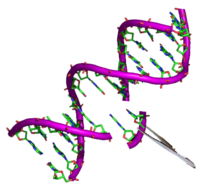
Photo from wikipedia
Models of the human gastrointestinal tract (GIT) can be powerful tools for examining the biological interactions of food products and pharmaceuticals. This can be done under normal healthy conditions or… Click to show full abstract
Models of the human gastrointestinal tract (GIT) can be powerful tools for examining the biological interactions of food products and pharmaceuticals. This can be done under normal healthy conditions or using models of disease-many of which have no curative therapy. This report outlines the field of gastrointestinal modeling, with a particular focus on the intestine. Traditional in vivo animal models are compared to a range of in vitro models. In vitro systems are elaborated over time, recently culminating with microfluidic intestines-on-chips (IsOC) and 3D bioengineered models. Macroscale models are also reviewed for their important contribution in the microbiota studies. Lastly, it is discussed how in silico approaches may have utility in predicting and interpreting experimental data. The various advantages and limitations of the different systems are contrasted. It is posited that only through complementary use of these models will salient research questions be able to be addressed.
Journal Title: Advanced healthcare materials
Year Published: 2019
Link to full text (if available)
Share on Social Media: Sign Up to like & get
recommendations!